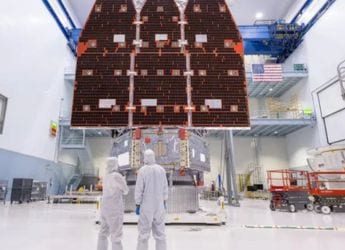- Home
- Science
- Science News
- NASA's Curiosity Rover Finds Clay Cache on Mars
NASA's Curiosity Rover Finds Clay Cache on Mars
Water interacted with sediment over time, leaving an abundance of clay in the rocks there, NASA said.

Photo Credit: NASA/ JPL-Caltech/ MSSS
Drilling by Curiosity Mars rover at a region of the Red Planet called the "clay-bearing unit" has revealed the highest amounts of clay minerals ever found during the mission, NASA has said.
The rover recently drilled two samples at rock targets called "Aberlady" and "Kilmarie", the US space agency revealed on Wednesday.
Clay often forms in water, which is essential for life. Other than proof that there was a significant amount of water once, what these new findings mean for the region is still up for debate.
It is likely that the rocks in the area formed as layers of mud in ancient lakes - something Curiosity also found lower on Mount Sharp mountain on Mars.
Water interacted with sediment over time, leaving an abundance of clay in the rocks there, NASA said.
This clay-enriched region is located on the side of lower Mount Sharp.
The rover's mineralogy instrument, called CheMin (Chemistry and Mineralogy), provided the first analyses of rock samples drilled in the clay-bearing unit, NASA said.
Get your daily dose of tech news, reviews, and insights, in under 80 characters on Gadgets 360 Turbo. Connect with fellow tech lovers on our Forum. Follow us on X, Facebook, WhatsApp, Threads and Google News for instant updates. Catch all the action on our YouTube channel.
Related Stories
- Samsung Galaxy Unpacked 2025
- ChatGPT
- Redmi Note 14 Pro+
- iPhone 16
- Apple Vision Pro
- Oneplus 12
- OnePlus Nord CE 3 Lite 5G
- iPhone 13
- Xiaomi 14 Pro
- Oppo Find N3
- Tecno Spark Go (2023)
- Realme V30
- Best Phones Under 25000
- Samsung Galaxy S24 Series
- Cryptocurrency
- iQoo 12
- Samsung Galaxy S24 Ultra
- Giottus
- Samsung Galaxy Z Flip 5
- Apple 'Scary Fast'
- Housefull 5
- GoPro Hero 12 Black Review
- Invincible Season 2
- JioGlass
- HD Ready TV
- Laptop Under 50000
- Smartwatch Under 10000
- Latest Mobile Phones
- Compare Phones
- Jolla Phone
- Realme P4x 5G
- OnePlus Ace 6T
- Nubia Flip 3
- Nubia Fold
- OPPO A6x 5G
- Samsung Galaxy Z TriFold
- Poco F8 Ultra
- Asus ProArt P16
- MacBook Pro 14-inch (M5, 2025)
- OnePlus Pad Go 2
- Poco Pad M1
- Just Corseca Skywatch Pro
- Honor Watch X5
- Acerpure Nitro Z Series 100-inch QLED TV
- Samsung 43 Inch LED Ultra HD (4K) Smart TV (UA43UE81AFULXL)
- Asus ROG Ally
- Nintendo Switch Lite
- Haier 1.6 Ton 5 Star Inverter Split AC (HSU19G-MZAID5BN-INV)
- Haier 1.6 Ton 5 Star Inverter Split AC (HSU19G-MZAIM5BN-INV)

















